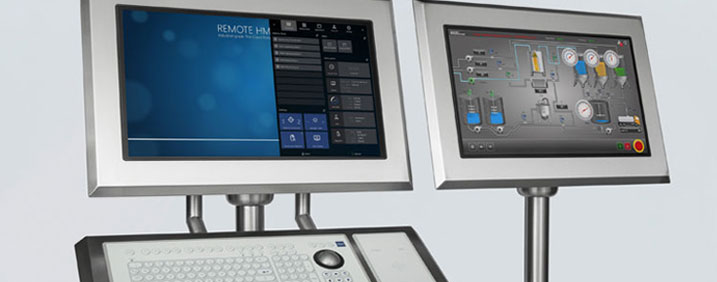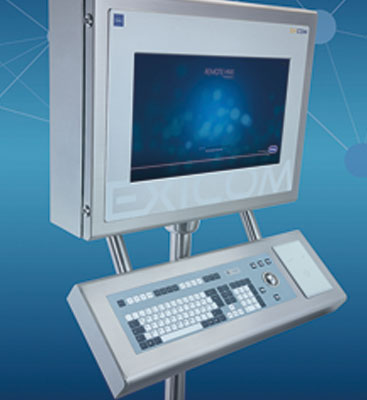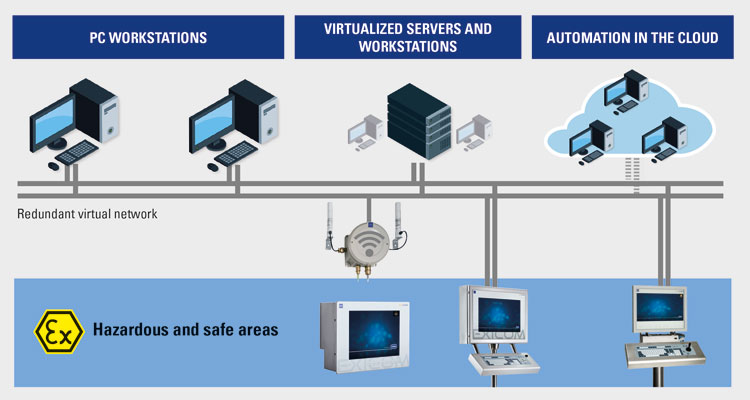Classic workstations and server units are increasingly being replaced by virtualised solutions that provide computing and storage capacities which are far more easily scalable, with lower cost and maintenance. Distributed control systems and cloud applications running on virtual machines enable flexible remote access to a wide range of systems – from process automation to condition monitoring and maintenance programs through to goods management systems. With regard to operation technology, conventional KVM systems are overstretched and are therefore being replaced with modern Thin Clients.
Flexible operator stations for remote access
Purely hardware-bound control and data transfer architectures are less and less able to deal with the ever-increasing volume of information. As a consequence, virtual machines or cloud systems have become established as more flexible, almost freely and quickly scaleable solutions. To ensure constant, secure access to process values, system status and production and maintenance processes from the field to the control station, both the hardware and the software of the field operating devices must meet the requirements of process and system control. Thin Clients with software optimised for the industrial Internet of Things are replacing traditional standard computers and KVM systems for remote access to distributed control systems.
Classic versions with connection problems
Compared with industrial PCs in the field, operator stations with a remote connection are the more compact, energy-efficient and low-maintenance solution in hazardous and non-hazardous areas. However, the classic version of a fixed connection between an explosion-protected HMI system and a workstation in a safe area is still quite common in the process industry. It consists of a remote terminal that is connected to a KVM box via a copper or FO cable. The KVM box in turn is connected to the keyboard, video and mouse interfaces of a PC workstation to transfer screen data to the remote terminal, and the input from the keyboard and mouse to the computer. With the use of fibre optic, transmission distances of up to 2 km can be covered. Current USB standards such as USB 3.0 or 3.1 are difficult to handle with such concepts, since the connected USB devices such as keyboard, mouse or touchscreen may fail due to interferences from the industrial environment, making it necessary to restart the host. Also, these systems lack the flexibility to be integrated seamlessly into higher network levels.
Classic KVM systems cannot be connected directly to virtual workstations. They do not have the physical interfaces for the keyboard, video and mouse, and these must be provided by another PC or Thin Client. While this type of hardware constellation is possible, it is much more expensive with regard to purchase price, commissioning and maintenance. The connection of operating and monitoring systems in the field to process control technology and higher network levels thus requires operator stations capable of connecting to a wide range of server architectures, including virtual machines and cloud automation.
Future-proof industrial IoT solution
Thin Clients provide a future-proof operating solution for the process industry, from the control centre to the field, but must be optimally tailored to the requirements of modern industrial networks and be compatible with all current control systems from leading manufacturers. The most important requirement is IT security.
Thin Clients should be closed, tamper-proof systems that can only be parameterised with password protection, for example. Integrity and availability are important characteristics of the firmware of these systems. Security features such as the Unified Write Filter and HORM (Hibernate Once / Resume Many) increase system stability and provide greater fail-safe functionality in industrial environments. Redundant Ethernet interfaces with automatic reconnection ensure fail-safe operation. Third-party applications – such as browsers, apps for the integration of camera images or Citrix – should only be available for secure access in Kiosk mode. Despite these features, the systems must be easy and ergonomic to configure.

R. STAHL's Thin Clients have been specially developed for the process industry with the above specifications, and can be used universally. They are available both for standard industry use and as explosion-protected versions certified according to ATEX and IECEx. Versions with hygienic design that are cleanroom-compliant are also available. The "industrial grade" Remote HMI V6 firmware, based on the Windows 10 Enterprise LTSC operating system, features rights management with tiered access rights to programs and applications stored centrally or in the cloud. The Remote HMI Device Manager can be used to configure and maintain all Thin Clients in a network from a central maintenance computer. The clearly structured, user-friendly operating interface with virtual keyboard and touchscreen-friendly operation features variable display options for multi-session and dual-screen display. The Remote HMI V6 firmware supports process visualisation and system operation via remote control on PC workstations, virtual server structures and cloud computer centres. To do this, the firmware can handle all common remote protocols – including the latest RDP version 10.2 and VNC 5.3 – and thus ensures flexible access from any HMI station to virtual or real workstations in a network. Using KVM-over-IP technology, older PCs or necessary KVM connections can also be incorporated into the network architecture. In addition to the Windows-based operating system, Linux-compatible versions with ThinManager via PXE Boot or IGEL OS are also available.
Conclusion
Conventional KVM systems can no longer cope with the growing interconnectedness of automation, electronics and information and communications technology. Thin Clients have proven to be the contemporary solution for flexible and secure access to distributed control systems and applications via servers, virtual machines or cloud services.
Further Reading:
These articles might also interest you

Use case: Provision of all documents and certificates







![[Translate to Englisch:] [Translate to Englisch:]](/fileadmin/user_upload/mitarbeiter/01_DE/07_Blog/00_Allgemein/blog-explosionsschutz-rstahl-startseite-279x205.jpg)
![[Translate to Englisch:] [Translate to Englisch:]](/fileadmin/user_upload/mitarbeiter/01_DE/07_Blog/00_Allgemein/blog-explosionsschutz-rstahl-ueber-den-blog-279x205.jpg)
![[Translate to Englisch:] [Translate to Englisch:]](/fileadmin/user_upload/mitarbeiter/01_DE/07_Blog/00_Allgemein/blog-explosionsschutz-rstahl-autoren-279x205.jpg)
![[Translate to Englisch:] [Translate to Englisch:]](/fileadmin/user_upload/mitarbeiter/01_DE/07_Blog/00_Allgemein/blog-explosionsschutz-rstahl-newsletter-expert-mail-279x205.jpg)
Write new comment